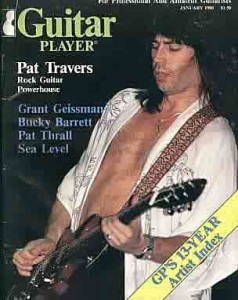Gettin’ Betta
 Hear a Pat Travers tune on the internet radio recently, one I hadn’t hear in a long while: Gettin’ Betta. Awesome tune (YouTube links to it below).
Hear a Pat Travers tune on the internet radio recently, one I hadn’t hear in a long while: Gettin’ Betta. Awesome tune (YouTube links to it below).
Reminds me a lot of Extreme, so Nuno Bettencourt obviously borrowed liberally from Pat.
Back in the day Pat used a Gibson Melody Maker with full-size Gibson humbuckers. In an old guitar Player interview he said, “Melody Makers are great guitars because they stay in tune, and you can bend the necks and do all kinds of things to them. I don’t like wham-o bars [vibrate bars] because the tuning problem just drives me up the wall, so I just got into bending the necks.”
His guitars were strung with Dean Markley 9s, and did not have any tone controls. “I basically just have two volume controls, one for each pickup,” he said. “I set the rhythm volume at 8, the lead volume at 10. The 8 setting seems to drop the guitar down quite a bit in volume, and it also changes the sound slightly. You lose a lot of your top end. But then if I back it down even more for some real quiet stuff, down to about 2 or 3, it seems that the top end comes back again. I don’t know why.”
On his effects chain, he said: “First I have the Phase 100. I’ve had the controls sawed off it with a hacksaw because I got fed up with either knocking them with my foot or having people readjust them. They have slots in them and can only be changed with a screwdriver. I set the phase cancellation control on the left to the most extreme setting, clicked all the way to the right. I run the speed about a little right of midway position. I’ve had this effect for about three-and-a-half years.
“From there I go into an MXR Blue Box, which adds a second pitch two octaves lower than the note you hit. I set the output control up full, and I vary the blend control between having it full right, so it gives me almost a distortion box sound, and blending it with the lower octave. You can’t play real, real fast with that thing at all because it’s just so noisy, fuzzy. I use that for real slow, sort of growly things on the low strings. It only works well in conjunction with a phaser; you really have to have the two together.
“After that 1 go to the Cry Baby wah-wah.
“[When] I come out of the pedalboard [I] go to a 50-watt Marshall, out of the 50-watt Marshall to two Maestro Echoplexes. I adjust one for whatever the tune is; usually it’s sort of on a long repeat. The next one is set on a real fast repeat, the closest one I can get. And that goes from there into my A/DA flanger so I in effect flange my echo repeats as well. So if I hit something, I’m not only flanging what I’m playing at the time, but also the repeats, so you get a spacey, ethereal sound. But because the repeats only go into the two 100-watt Marshalls I use, I get a nice stereo effect on-stage, especially on the real short delay. I also go into a Leslie, but that’s a separate output from the pedalboard. That’s on all the time; it’s just part of the overall sound I get.”
Wow. Sounds similar to Edward Van Halen’s re-amping technique to me (this interview was done in 1980).
Pat added that he also used a 100-watt Altair power attenuator.
Now Pat plays a PRS through a Marshall JCM 900 (yes, 9, not 8!), plus he has several rack effects that can be seen here. Doesn’t sound like it would be Woody at all, but in his hands it is, as you will see and hear below.
Pat’s website is www.pattravers.com.
Here’s another good, recent version — possibly better — but it can’t be embedded.
http://www.youtube.com/watch?v=cpQ2BjtdMvM
Here’s Paul Gilbert and Nuno Bettencourt doing a version of the tune:
Category: Gibson, Marshall, Nuno Bettencourt, Pat Travers, Paul Gilbert, PRS













